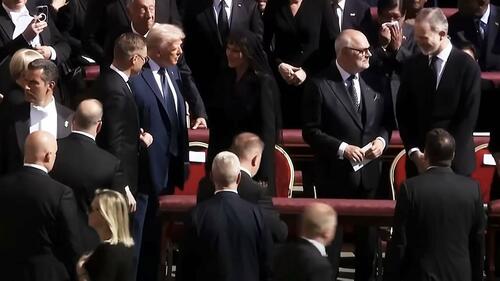GBPUSD: Fear Sentiment Analysis Signals Bearish Market
Tháng 4 27, 2025USDJPY: Sideways, Neutral Market Prediction Analysis
Tháng 4 27, 2025The Controversy Over Trump’s Attire at Pope Francis’ Funeral: Balancing Tradition and Individual Expression
The recent funeral of Pope Francis brought together dignitaries from around the globe, all gathered to pay their respects in what is traditionally a somber and austere occasion. However, one particular attendee has ignited a firestorm of debate: former President Donald Trump. His choice of attire—a bright blue suit, light blue tie, and an American flag lapel pin—stood in stark contrast to the predominantly black outfits worn by other attendees, leading to widespread criticism and discussions about decorum at such significant events.
Trump’s Eye-Catching Attire: A Breach of Tradition?
Trump’s attire at the funeral of Pope Francis was not just bright; it was a bold statement that some believe crossed the line of acceptable mourning attire. Traditional protocols typically dictate that attendees wear dark, somber colors—black being the established standard for funerals, particularly those of significant religious leaders. This emphasis on dress is not just a matter of personal style; it is deeply rooted in respect for the occasion and the traditions that govern it.
While many observed the strictly followed dress code, Trump’s outfit emerged as the most notable deviation, leading to questions about appropriateness and respect. Interestingly, Trump’s predecessors have also chosen to incorporate elements of color in similar contexts. For instance, President Joe Biden was observed wearing a blue tie at a high-profile funeral, facilitating a discussion about whether there’s a gradual shift in how leaders approach such events. Nevertheless, many argue that traditional black attire is a timeless standard that should be upheld, particularly at the funeral of a key religious figure.
The Choices of Other Leaders: A Spectrum of Styles
Interestingly, Trump was not alone in his deviation from traditional black clothing at this somber ceremony. Other notable figures, such as Prince William, opted for a dark blue suit as well. Similarly, President Droupadi Murmu and Biden also integrated blue elements into their ensembles—be it ties or accessories—suggesting that the palette of mourning attire is not entirely limited to black.
These choices by other leaders introduce a more nuanced conversation about personal expression within the confines of cultural and religious traditions. While it is essential to honor the solemnity of such occasions, individual preferences can emerge, reflecting personal or even cultural influences. However, the reception of these decisions can vary widely, with public opinion divided along the lines of tradition versus interpretation.
Public Reaction: Debating the Balance of Tradition and Expression
The public reaction to Trump’s outfit has encapsulated a broader debate that transcends the attire itself. Critics have voiced their concerns, deeming the choice as insensitive and disrespectful when honoring the passing of a universally respected figure. This controversial moment has served as a litmus test for what it means to balance personal style with adherence to the conventions of mourning and respect in highly revered settings.
As discussions around attire at formal events continue to evolve, this incident emphasizes the challenges that accompany the intersection of individual expression and established traditions. The varying responses reflect the dynamic cultural conversations we are having today, underscoring that in a world increasingly defined by personal expression, finding a balance that respects tradition while embracing individuality remains a complex endeavor.
In conclusion, the controversy surrounding Donald Trump’s attire at Pope Francis’ funeral is much more than a disagreement over fashion; it is a reflection of our evolving societal values and the ongoing dialogue about respect, tradition, and personal expression in formal ceremonies. As fashion continues to dance along with cultural expectations, events such as these will undoubtedly spark further conversations that resonate with audiences around the world.

